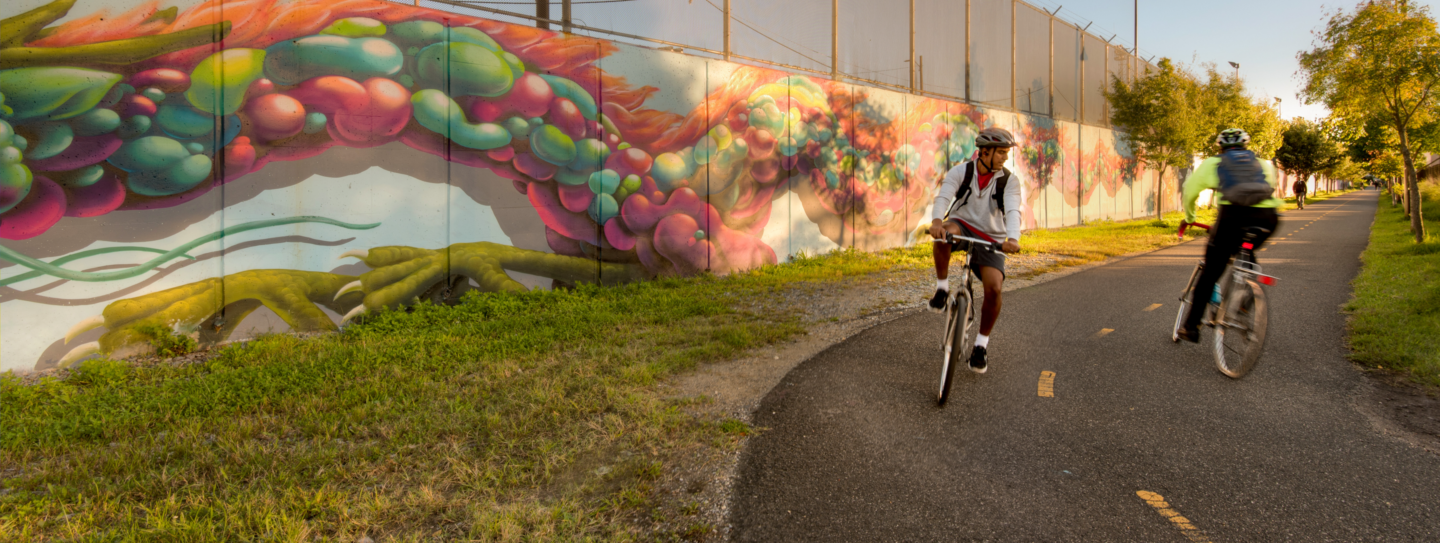About the Strategic Plan
An organizational Strategic Plan is a complex document combining vision, research, and understanding of our work inside and out. This is what went into ours.
Letter From the BID President & Board Chair
Partners, friends, and colleagues,
It’s an incredibly exciting time for NoMa. The neighborhood has grown into a vibrant and vital part of DC, and is still being shaped into what it will ultimately become. For the past year, the NoMa Business Improvement District (NoMa BID) has been reflecting, studying, analyzing, and envisioning—both to assess where we are and to plan for what lies ahead. We are pleased to present the NoMa BID’s strategic plan for the years 2022-2026.
Over the past five years, NoMa has continued to experience phenomenal growth. At the end of 2016, the NoMa BID included 15.9 million square feet of built space. Today, that number is nearly 21 million. Much of this growth came in the residential sector, with the volume of multifamily units increasing from about 3,400 to 7,300 (a 115% increase). Goals of adding retail and parks were realized, with retail square footage increasing from 378K to 538K over that same period and NoMa’s third state-of-the-art park about to start construction. Over the next two years, that rate of residential and retail growth is expected to be exceeded, and the number of hotel rooms in NoMa will more than double. Meanwhile about 80 residents are moving to NoMa each month, in 2021, and office occupancy continues to outperform the rest of the District of Columbia.
NoMa is greater and more vibrant than we could have even dreamed a decade ago—which tells us we need to be dreaming bigger. This Plan lays out our strategies to ensure that NoMa’s future continues to exceed our expectations and becomes an even more prominent, connected, and desirable urban destination. Not only will this plan guide our work over the next five years, it will allow us to position the neighborhood for continued growth and maturation over the next ten, fifteen, twenty years, and beyond.
The NoMa community was essential to the development of this plan and we are grateful to those who helped shape it. More than thirty people—including industry experts, local business owners, and residents—generously lent their time, expertise, and perspective to this process and the plan is richer because of it.
The NoMa BID will continue to build on the tremendous strengths of the community and guide the neighborhood towards its future. We hope you will join us on this journey.
Sincerely,



Approach
How We Developed the Plan
Strategic plans have long lives, and this one began well before the end of the previous plan. As tracking of key performance indicators and evaluation of the 2016 plan was underway at the start of the 2020 fiscal year, the first elements of this plan began to take shape.
With the hiring of Chief of Staff Daniel Hoagland in January, the BID began devoting resources specifically to the formulation and design of the new plan. BID leadership built out an 18-month process designed to deliver a plan by the summer of 2021, in time for the plan to begin with the 2022 fiscal year that October.
We began by seeking input from as many stakeholders and sources as possible. We brought together the staff, board, and community to form committees that would provide guidance and feedback. We commissioned original research and analyzed the work of experts in planning, placemaking, real estate, and more.
We worked with a public opinion firm to convene focus groups of people who live and work in NoMa and conduct individual interviews with prominent individuals in development, retail, and real estate. Our committees dedicated their time and energy key topics: culture and identity, connectivity, community and inclusivity, the pandemic.
On the quantitative side, we built a comprehensive research framework examining retail, residential, and office outlooks for the five years of the plan, together with best-in-field predictions for post-pandemic recovery, and a range of financial projections. To this we added the results of our own biannual community surveys and the outcomes from the 2016 plan.
Acknowledgements
This strategic plan would not have been possible without the contributions of the following people, organizations, and businesses. We thank them for their work and for their confidence in and support of the NoMa BID.
We Acknowledge:
The leadership of Robin-Eve Jasper, NoMa BID President 2008-2021
The leadership of Maura Brophy, NoMa BID President 2021-
The work of NoMa BID staff past and present, and specifically the contributions of:
- Daniel Hoagland, Chief of Staff
- Jesse London, Planning and Economic Development
Senior Manager
The guidance and work of the NoMa BID Board of Directors, and specifically the members of the Strategic Planning Committee:
- Caiti Anderson of REI
- Brigg Bunker of Foulger-Pratt
- Josh Dix of Trammel Crow Company
- Mike Ponticelli of Bisnow Media
- Matt Robinson of MRP Realty
- Pam Tapscott of Mathematica
The NoMa community, and specifically the members of the Community Strategic Planning Committee:
- Drew Courtney, ANC 6C commissioner
- Kim Cox, Father McKenna Center
- Heather Edelman, NoMa resident
- Anne Phelps, NoMa resident
- Conor Shaw of the Eckington Civic Association
- Eric Shin of Seoul Spice
- Gerard Wall, NoMa resident
- Kamille Warren, NoMa resident
The facilitation, skill, and guidance of Bill Potapchuk and the Community Building Institute
The time and thoughtfulness of our interviewees and focus group participants
The insightful work of our research partners:
- Gensler
- The DC Policy Center
- RKG
- OpinionWorks
The photography of Sam Kittner, as well as Allen Russ and Emma McAlary.
Deriving Targets & Tracking Outcomes
Tracking progress against this plan will be critical to our success. As such, the BID will identify key performance indicators, set targets, and monitor progress. The approach we take to establishing these targets will reflect the strategic vision we’ve identified, in that it will consider targets that can be achieved within the 5-year plan period, and also the “positioning” of the neighborhood for growth beyond the next five years given its longer-term trajectory. For instance, while we will certainly track progress towards achieving our overarching goal of “making NoMa magnetic,” we will also aim to evaluate our progress within our strategic Pillars and our vision for the growth of NoMa long-term. An important thing to note given the nature of this plan is that some measures will be quantitative while others will be qualitative, however they will all be integral to our success.
Evaluation & Feedback
A successful strategic plan is a living document that is periodically reviewed by both its creators and its users, with an eye towards changing contexts and constraints as opportunities for adaptations are evaluated.
For this plan, periodic evaluations by the staff and the board (and additional stakeholders) will include the following questions:
- Is the goal still effective and achievable?
- Are the Pillars still valid and connected to achieving the goal?
- What progress has been made on the initiatives and are there any that have been completed?
- What new initiatives may have arisen that should be included?